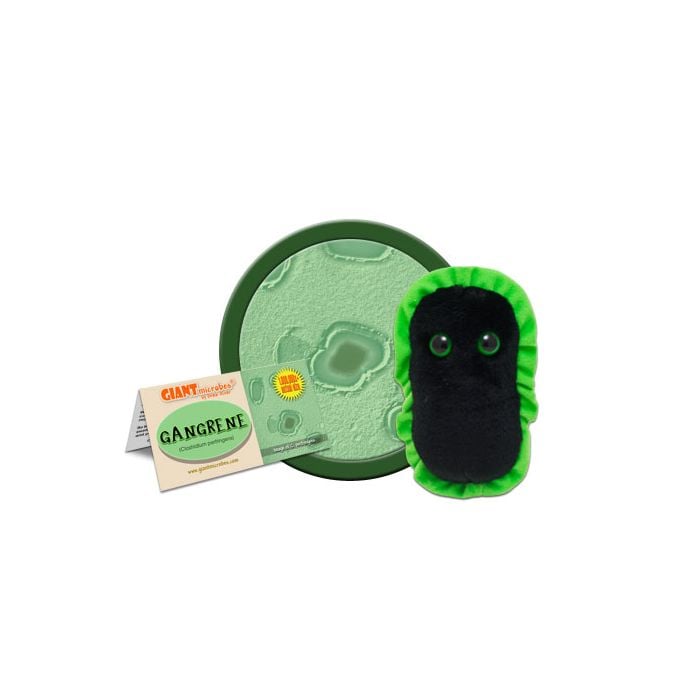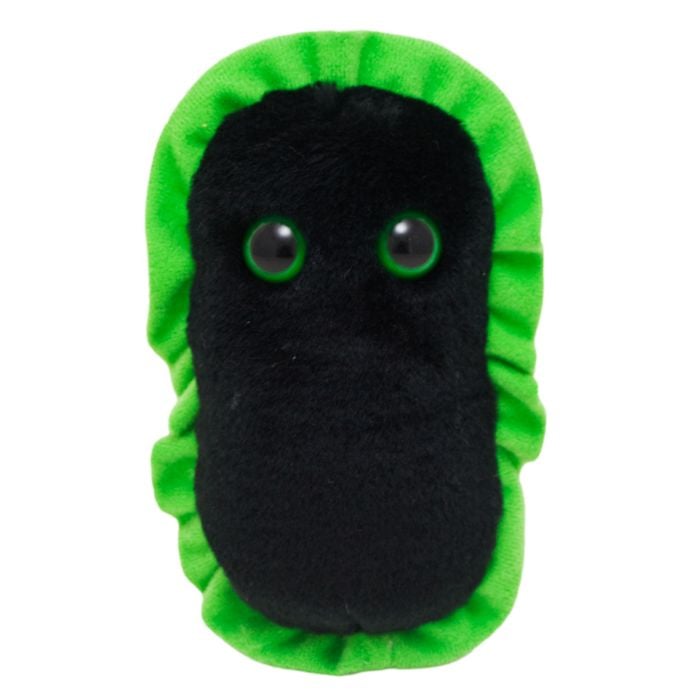Gangrene (Clostridium perfringens)
Product Details
Additional Information
| Sizes | Giantmicrobes are based on actual microbes, cells, organisms and other critters, only 1,000,000 times actual size! Gigantic (GG) 16-24" XL (XL) 10-15" Original (PD) 5-8" Keychain (KC) 2-4" with clip |
|---|---|
| Materials | Plush from all new materials. Stuffed with polyester fiber fill. Surface washable: sponge with water & soap, air dry. |
| Packaging | Each plush microbe includes a printed card with fun, educational and fascinating facts about the actual microbe or cell. |
| Safety | Every product meets or exceeds U.S. and European standards for safety. For ages 3 and up. |
All about Gangrene (Clostridium perfringens)
FACTS: Although gangrene may sound like a hazard of jungle exploits and military campaigns, the gruesome decay and death of soft body tissue that characterizes the condition can happen to anyone anywhere. There are two common types of gangrene: dry and wet. Dry gangrene occurs when blood flow is interrupted to part of the body. Affected areas dry out and eventually blacken as tissue is slowly mummified. Dry gangrene typically occurs in the fingers and toes, often in the elderly or in those living with diabetes.
Wet gangrene occurs when infection accompanies the interrupted blood flow. Bacteria such as clostridium perfringens, which produce toxic gases that can bubble up under the skin, are often implicated.
Although wet gangrene typically occurs after physical trauma or surgery, the bacteria responsible are widespread and infections can occur more or less spontaneously. It is extremely fast-spreading and can be fatal if left untreated.
While it is possible to treat gangrene, it can be complicated and can cost you an arm and a leg—literally. Intravenous antibiotics are often required, as is surgery to remove infected areas and prevent spreading.
So keep an eye out for warning signs such as persistent pain, numbness, swelling, or strangely discolored skin. Because it’s a jungle out there, and you don’t want to find yourself in a fight for your life.
| Name | C. perfringens gets its name from the toxin it produces, which causes pierces through red blood cells. Perfringens originates from the Latin root ‘perforatus’, meaning to pierce. |
|---|
| Actual Size | 600 x 4000 micrometers, or one thousand times smaller than a grain of rice! |
|---|
| Where It Lives | Clostridium perfringens is a bacteria that commonly causes food poisoning that lasts 24 hours. It’s found everywhere in the environment and cause disease when found in food that has not been stored properly. Meats, casseroles, and gravy are the most common sources of C. perfringens so remember to put away those leftovers! It also causes rapid tissue death called gas gangrene when it comes in contact with surgery sites or deep wounds. |
|---|
| Symptoms | Food poisoning with C. perfringens causes abdominal pain, stomach cramps, nausea, and diarrhea. Gas gangrene causes pain, fever, vomiting, and the infected area becomes swollen, produces a foul smell, and turns gray and black. |
|---|
| Cure | For food poisoning, just keep hydrated. High doses of antibiotics are needed to treat gas gangrene and surgery may be needed to remove dead tissue. |
|---|
| History |
1892: First isolated and described at Johns Hopkins Hospital by American physician, William H. Welch. Big Outbreaks: 1914: During World War I, 6% of war injuries were complicated by gas gangrene Recent Outbreaks: 2012: Outbreak at a state psychiatric hospital in Louisiana that affected 54 people. 2015: Outbreak of food poisoning by C. perfringens at Roosevelt High School in Des Moines, Iowa |
|---|
| Fascinating Facts |
Originally, this microbe was named Bacillus welchii, after the scientist that discovered it. It was renamed to Bacillus perfringens after its toxin activity then changed to Clositridum perfringens when the Bacillus genus was renamed. This microbe has had as many name changes as former American NFL player, Chad “Ochocinco” Johnson! Famous people who died of it: 1911: Jasper Newton Daniel, famed whiskey maker also known as Jack Daniel |
|---|





